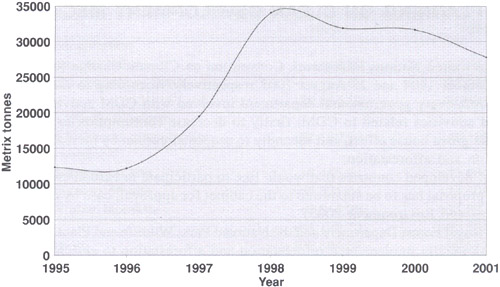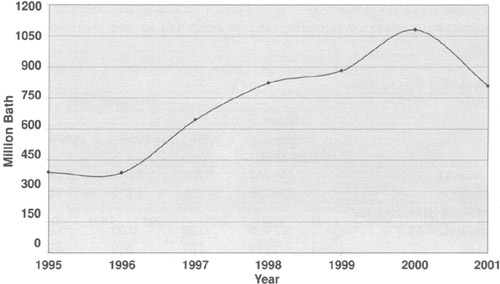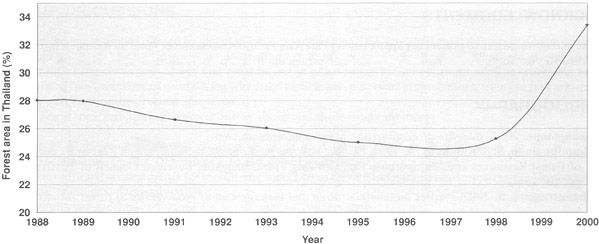Suchitra Changtragoon[32]
ABSTRACT
Improving the living status of disadvantaged rural people is one of the main policies of the Government of Thailand, which is firstly to decrease their expenditure, secondly to increase their income, and lastly to enhance their economic opportunities. Most of the rural people in Thailand rely on agriculture and forests for their living. In this paper the prospects of alleviating their poverty based on biodiversity conservation through ecotourism management and food banks from forest community establishment as well as forest plantations for medicinal and natural product investment are proposed. The opportunity of future benefits from Clean Development Mechanism (CDM) contribution in Thailand is also discussed.
BIODIVERSITY AS THE SOURCE OF ECOTOURISM BENEFITS
Natural forests are the source of biodiversity which can provide income and benefits to rural people through ecotourism. At present ecotourism involves travelling to natural areas with specific objectives of studying, admiring and enjoying the scenery and its wild plants and animals while conserving the biological diversity and natural condition of the environment as well as improving the welfare of the local people. This is in line with the world conservation movement, and also with the policy and planning of the National Park, Wildlife and Plant Conservation Department of Thailand for natural resources and biodiversity conservation and sustainable development with people participation.
USAID (1995) has identified ecotourism as an enterprise with potential positive contributions to the conservation of endangered biological resources. Contributions of ecotourism include raising local awareness about the value of biological resources, increasing local participation in the benefits of biodiversity conservation (through new sources of jobs and income), and generating revenues toward conservation of biologically rich areas (Anonymous 2002). Wood (2002) pointed out that ecotourism is a growing niche market within the larger travel industry, with the potential of being an important sustainable development tool. With billions of dollars in annual sales, ecotourism is a real industry that seeks to take advantage of market trends. At the same time, it frequently operates quite differently from other segments of the tourism industry, because ecotourism is defined by its sustainable development results: conserving natural areas, educating visitors about sustainability and benefiting local people.
Chettamart (2003) mentioned in his paper concerning ecotourism resources and management in Thailand that the current Government of Thailand is keen on tourism development, as stressed by the Prime Minister Thaksin Shinawatra in his official declaration of the government policies to the National Assembly in early 2001. The Prime Minister said that the tourism industry could very well be the country’s substantial income earner and, in turn, could help to solve its current economic problems. He then pledged to increase the diverse forms of tourism and to upgrade the quality of all tourism products, targeting ecotourism, health tourism, nature tourism and services to ensure their long-term competitiveness with other countries. He also stated that new tourist sites must be developed and promoted. Communities must be able to play a greater role in tourism management (Emphandhu 2002).
The Tourist Authority of Thailand (TAT) has run a campaign “Unseen Thailand” to promote the exploration of 54 unseen places including nature-based ecotourism spots in Thailand, in addition to the previous “Amazing Thailand” campaign. This input is one way to distribute income to the local people who rely on natural forest and so far is a very successful project. The National Park, Wildlife and Plant Conservation Department has also encouraged people participation in nature-based ecotourism by training the local people, youths and students who rely on the natural forest to act as ecotourism guides, conversant in both Thai and English. This project is also very successful and is ongoing since the local people and the young generation can get income as tour guides as well as cultivate awareness on natural forest conservation and its value (Changtragoon 2003).
There are 1385 nature destinations for ecotourism in Thailand (Saetharuk 2001). Most of them are located in national parks and protected areas. In Thailand there are 319 protected areas comprising 145 national parks, 53 wildlife sanctuaries, 52 non-hunting areas and 69 forest parks (Chettamart 2003). Income from the entrance fees and accommodations for the ecotourists visiting the national parks in Thailand has increased gradually from 1993 to 1999, and steeply thereafter as shown in Figure 1. It is a normal practice that five percent of the income from these fees go to a community fund. The people living near or inside the natural forest derive additional income by providing accommodations, meals, drinking water, food, traditional cultural entertainment and guided tours for the ecotourists. Some communities can manage ecotourism on their own, some get income through ecotourism companies. However, a problem still remains in the proper management of the local people’s participation and a fair distribution of income for their involvement.

Figure 1. Income from entrance fees to national parks managed for ecotourism in Thailand during 1993-2002
BIODIVERSITY AS A SOURCE OF FOOD BANK AND ECONOMIC INVESTMENT ON MEDICINAL PLANTS AND NATURAL PRODUCTS
Most of the local people in Thailand rely on forest products as sources of food, medicine plants and other uses. It is estimated that about 80 percent of at least 18 000 forest trees and plants in Thailand are medicinal plants. Bhumibhamon and Kamkong (1997) reported that 242 multipurpose tree species are edible and are being consumed by the local people. At least 300 plant species are aroma trees (Kamkong 2002). At present, medicinal plants and their application are very popular in Thailand. Both government and non-government organizations are encouraging rural people to establish medicinal plants in their gardens and communities for their own use. Besides, under the campaign of the Government of Thailand on “one (tambom) district one product”, medicinal plants and natural products are also sources of their additional income. On a broader scale, at least 80 private companies and a number of hospitals in Thailand have invested in medicinal plants as sources of local medicines and natural products for local consumption and export. Figures 2 and 3 show the business trends of medicinal plants and spices for export from 1995 to 2001. The decline in the recent years may be due to the economic crisis and shortage of materials. Because of the high demand for plant materials in this business, it is known that some of the materials have come from harvesting of medical plants and trees in the natural forests.

Figure 2. Export of medicinal

Figure 3. Income from the export of medicinal plants and spices from Thailand
Therefore, there should be a proper plan for the conservation and sustainable utilization of plants for medicine and as a source of local food bank through the establishment of plantations and management of forest communities. Investment on plantations of medicinal and aroma as well as spice plants to supply the medicinal and natural products business is encouraged for the local people. The Government of Thailand has also identified 2512 forest communities (Table 1) as sources for the production of food and medicinal plants as well as natural products and to increase their income. To maintain these sources in a sustainable way, one example is the project on the exploration of biodiversity through local people participation which has been planned to start in October this year stretching to 2007 by the Ministry of National Resources and Environment. By this means local people from 4088 districts of 70 provinces in an areas of 164 018.78 km2 will know the status of plants and forest trees as well as the wildlife stock in their communities and can manage these resources with the assistance of experts to conserve and utilize the biodiversity more efficiently and sustainably (National Resources and Environment 2003).
Table 1. Numbers and areas of approved forest communities in Thailand
|
Location |
Number of communities |
Number of projects |
Area (ha) |
|
Central |
402 |
382 |
13 709.76 |
|
North |
761 |
735 |
57 720.96 |
|
South |
265 |
260 |
4 367.84 |
|
Northeast |
1084 |
926 |
43 367.68 |
|
Total |
2512 |
2303 |
119 166.24 |
POLICY AND PLANNING ON CLEAN DEVELOPMENT MECHANISM (CDM) IN THAILAND
Thailand ratified the United Nations Framework Convention on Climate Change (UNFCCC) and the Kyoto Protocol on 28 December 1994 and 28 August 2002 respectively. According to the Thai cabinet resolution on 10 September 2002, every governmental department involved with CDM activities has been assigned to initiate projects and activities related to CDM, firstly to decrease consumption to reduce air pollution and gas release that cause green house effect, and secondly to sequester carbon by increasing and sustaining green areas by reforestation and afforestation.
In the case of developed countries that would like to participate in carbon credit projects in Thailand, every CDM project proposal has to be submitted to the cabinet for approval, case by case (Policy and Planning of Natural Resources and Environment 2003).
Actually, the Royal Forest Department and the National Park, Wildlife and Plant Conservation Department of Thailand have continually implemented reforestation and afforestation to enrich the green area (Table 2) as well as encouraged the private sector and local people to invest in forest plantations for wood and fiber production since several years ago, before the CDM of the Kyoto Protocol was set up. Getting the local people and private companies to invest in forest plantations to benefit from the CDM projects may take some time due to their lack of understanding and information of CDM contribution and also their unclear comprehension of CDM regulations and management from the Kyoto Protocol. However, this year the Government of Thailand has planned to initiate the incentive project on setting up sustainable green zones in towns and communities as botanical and community gardens by reducing land property tax for the local people who use their own lands for this purpose.
Table 2. Annual reforestation by objective
|
Item |
Area (ha) |
|||||
|
|
From beginning to 1996 |
1997 |
1998 |
1999 |
2000 |
2001 |
|
Afforestation by government budget |
645 184 |
6 203 |
6 592 |
9 283 |
5 477 |
3 840 |
|
The reforestation campaign in commemoration of the Royal Golden Jubilee |
299 885 |
30 268 |
10 211 |
15 348 |
12 972 |
16 005 |
|
By Forest Industry Organization (FIO) |
27 025 |
0.00 |
0.00 |
59.24 |
710 |
0.00 |
|
By Thai Plywood Co., Ltd. |
1 174 |
701 |
619 |
694 |
378 |
341 |
|
Reforestation according to Ministry’s regulations |
12 564 |
234 |
971 |
1 337 |
1 478 |
1 914 |
|
Reforestation by concessionaire budget |
20 869 |
651 |
898 |
40 |
54 |
138 |
|
Total |
1 006 701 |
38 057 |
19 291 |
32 626 |
21 069 |
22 238 |
The carbon dioxide exchange characteristics and biomass of tropical tree species under various environmental conditions have been investigated. The results show that the gross carbon dioxide uptakes by deciduous forest and teak plantation were 86.65 and 59.83 tonnes ha-1y-1 respectively (Puangchit 2001). The carbon dioxide emission and sequestration from forest in 1990 and 1994 have been compared by Puangchit (1994) using secondary data on forest area and biomass. The results show that the net emission has been reduced in 1994 compared with 1990 (Table 3). These results may be improved by the reforestation programmes in Thailand. If this assumption is correct, the net carbon dioxide emission in Thailand may have dropped in recent years due to the increasing forest area as shown in Figure 4. Research on carbon sink on above-and below-ground biomass in different natural forest types and plantations is ongoing (Laengjame and Diloksampan, personal communication).
Table 3. Carbon dioxide emission and sequestration from forest, 1990 and 1994 (Gg)
|
|
1990 |
1994 |
|
Carbon sequestration |
|
|
|
Uptake from plantation |
-812.50 |
-17,457.26 |
|
Uptake from secondary forest |
-24,151.60 |
-21,644.34 |
|
Total |
-24,964.10 |
-39,101.60 |
|
Change in woody biomass |
|
|
|
Wood and fuelwood consumption |
+21,160.59 |
+40,180.51 |
|
Forest conversion |
|
|
|
Biomass burning on site |
+6,455.61 |
+13,650.78 |
|
Biomass burning off site |
+68,321.84 |
+14,508.08 |
|
Decay of timber biomass |
+6,946.28 |
+31,237.98 |
|
Total |
+81,723.73 |
+59,396.84 |
|
Total emission |
+102,884.32 |
+99,577.35 |
|
Net emission |
+77,920.22 |
+60,475.75 |

Figure 4. Percentage of forest area in Thailand from 1988 to 2000
DISCUSSION AND CONCLUSION
Biodiversity can be used to provide benefits to the rural people which can be summarized as shown in Figure 5. However, proper management should be carried out to improve benefit sharing and distribute the opportunities to earn the new income for the rural people, so that their living standard will be upgraded. At the same time, the conservation of biodiversity should be managed properly and efficiently so that the forest resources can be maintained and used in a sustainable way.
Concerning CDM, at this stage the potential for poverty reduction in terms of carbon credit contribution may take some time with respect to reforestation and afforestation in Thailand. However, the activities relating to CDM are ongoing and encouraged by the Thai Government, case by case. The input of CDM based on biodiversity from standing natural forests and green zones as well as public parks in developing countries deserve consideration.

Figure 5. Opportunities for poverty alleviation through biodiversity conservation
ACKNOWLEDGMENTS
The author would like to express her appreciation to the Asia Pacific Association of Forestry Research Institutions (APAFRI) for the invitation and support of her presentation and participation in this workshop.
BIBLIOGRAPHY
Anonymous. 2002. Benefits of ecotourism. www.untamedpath.com
Bhumibhamon, S. & Kamkong, A. 1997. Eatable multipurpose trees. Subcommittee on Research Coordinator of Forest Resources and Multipurpose Fast Growing Trees. Bangkok, Research Council of Thailand. 485 pp. (in Thai)
Changtragoon, S. 2003. Project on administration and management of biodiversity of forest resources and wildlife for conservation and sustainable utilization development. National Park, Wildlife and Plant Conservation Department. 31 pp. (in Thai)
Chettamart, S. 2003. Ecotourism resources and management in Thailand. Malaysia-Thailand Technology and Business Partnership Dialogue, 27-28 July, Langkawi, Malaysia. 16 pp.
Emphadhu, D. 2002. Community-based tourism in protected areas. Research Team Meeting, Strategy for Facilitating Community-Based Tourism in Protected Areas under APEIS Project, 12-13 November 2003, Tokyo, Japan.
Kamkong, A. 2002. Aroma multipurpose trees. Proceedings of Conference on Multipurpose Trees and Thai Culture. Volume 2, pp. 135-145. (in Thai)
Ministry of Natural Resources and Environment. 2003. Survey of biodiversity in community level project. The Office of Ministry of Natural Resources and Environment, Ministry of Natural Resources and Environment. 38 pp. (in Thai)
Policy and Planning of Natural Resources and Environment. 2003. Report on the meeting of the Subcommittee on Planning and Management of Community Environment. Policy and Planning of Natural Resources and Environment, 17 June 2003. 14 pp. (in Thai)
Puangchit, L. 2001. Thailand’s national greenhouse gas inventory 1994, Forest sector: Chapter 6. Ministry of Science, Technology and Environment.118 pp.
Puangchit, L. 2004. Carbon dioxide exchange characteristics and biomass of tropical tree species under various environmental conditions. Complete report presented to the Office of National Research Council, Thailand. 39 pp.
Saetharuk, A. 2001. The natural park development for ecotourism. Thailand, Royal Forest Department. 218 pp. (in Thai)
| [32] Forest Genetic Engineering
Division, National Park, Wildlife and Plant Conservation Department, Bangkok,
Thailand; Email: [email protected] |